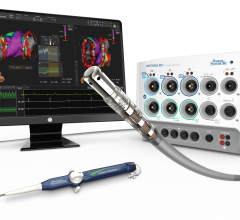August 16, 2011 — Vital Images Inc. received 510(k) clearance from the U.S. Food and Drug Administration (FDA) for VitreaView, a new universal viewer providing uniform access to all images within patient imaging. VitreaView is designed for access through the electronic medical record (EMR), electronic health record (EHR) and health information exchange (HIE). Vital Images is a Toshiba Medical Systems Group company.
August 12, 2011— Simbionix USA Corp., a provider of medical simulation training and education products for medical professionals and the healthcare industry, has been granted a patent in the United Kingdom for its innovative Procedure Rehearsal Studio.
August 12, 2011 — Endologix Inc. announced that the first American commercial implant of the company's AFX Endovascular AAA system was performed at Edward Hines, Jr. VA Hospital in Chicago. Ross Milner, M.D., F.A.C.S., associate professor and chief of vascular surgery & endovascular therapy at Loyola University Chicago performed the procedure.
SPONSORED CONTENT — Studycast is a comprehensive imaging workflow system that allows healthcare professionals to work ...
August 12, 2011 — SynCardia Systems Inc., manufacturer of the temporary Total Artificial Heart (TAH). said Aug. 2, Papworth Hospital in Cambridge discharged the United Kingdom's first TAH patient. He was sent home to wait for a matching donor heart with his wife and 5-year-old son using the Freedom portable driver.
August 11, 2011 — A physician studying the link between behavior and diet and exercise in African-American men is the inaugural recipient of the first award issued by the Coalition to Reduce Disparities in Cardiovascular Disease Outcomes, or CREDO. The coalition is part of the American College of Cardiology (ACC).
August 11, 2011 – GE Healthcare announced U.S. Food and Drug Administration (FDA) clearance of Optima CT660 – a compact computed tomography (CT) system offering improvements from its predecessors in diagnostic capabilities at low dose levels. The system is designed for sustainability and ease-of-use.
Providing exceptional cardiovascular care for patients to achieve the best possible outcomes is the number one goal for ...
August 11, 2011 – Researchers have found more evidence supporting the role of fat around the heart in promoting atherosclerosis, according to a study published online in the journal Radiology.
August 10, 2011 — Hospitals vary markedly when it comes to the rate at which diagnostic coronary angiography or catheterization – an invasive procedure that allows doctors to see the vessels and arteries leading to the heart – actually finds obstructive coronary artery disease (CAD) in people without known heart disease.
August 10, 2011 – The U.S. Food and Drug Administration (FDA) has approved Abbott’s RX Herculink Elite Renal Stent System for the treatment of renal artery stenosis (narrowing of the main arteries supplying blood to the kidneys) in patients with uncontrolled hypertension (high blood pressure). Over time, narrowed kidney arteries can lead to kidney failure and increased risk of heart disease, stroke and peripheral artery disease. This approval is supported by the HERCULES (Herculink Elite Cobalt Chromium Renal Stent Trial to Demonstrate Efficacy and Safety) study, which demonstrated that RX Herculink Elite is safe and effective in patients with renal artery stenosis and uncontrolled hypertension.
Cardiac positron emission tomography (PET) is growing in popularity among cardiologists because it provides the ability ...
August 10, 2011 – In the 3.0 Tesla (T) magnetic resonance (MR) marketplace, patient compliance often impacts image quality and patient throughput. As the only 3.0T MR system designed to improve patient compliance and comfort while offering advanced radiology capabilities, Toshiba America Medical Systems Inc.’s new Vantage Titan 3.0T open-bore MR has received U.S. Food and Drug Administration (FDA) clearance. The new system is the only 3.0T MR offering patient-friendly features such as noise reduction, a wide and open bore, feet-first imaging and Toshiba’s proprietary contrast-free techniques.
August 9, 2011 — Boston Scientific Corp. said the U.S. Court of Appeals for the First Circuit has affirmed the dismissal of a securities fraud case in connection with the 2004 recall of one of the company’s coronary stent systems.
August 9, 2011 — Acist Medical Systems Inc., a Bracco Group company and provider of advanced contrast injection system technology for cardiovascular angiography, announced that its’ Contrast Delivery System has been used to help diagnose and treat 10 million patients.
When performing radiofrequency (RF) ablation to treat cardiac arrhythmia, medical professionals must balance the safety ...
August 9, 2011 — The American Heart Association (AHA) 2011 annual scientific sessions will be held Nov. 12-16, in Orlando, Fla.
August 8, 2011 – Edwards Lifesciences announced the global launch of the Carpentier-Edwards Physio Tricuspid Annuloplasty Ring for the treatment of tricuspid valve insufficiency. The company received both 510(k) clearance from the U.S. Food and Drug Administration (FDA) and CE mark for European sales of the device.
August 8, 2011 — Elsevier, provider of scientific, technical and medical information products and services, announced its Braunwald's Heart Disease Practice Guides App for iPad, iPhone and iPod Touch is now available on the App Store.


 August 16, 2011
August 16, 2011
















